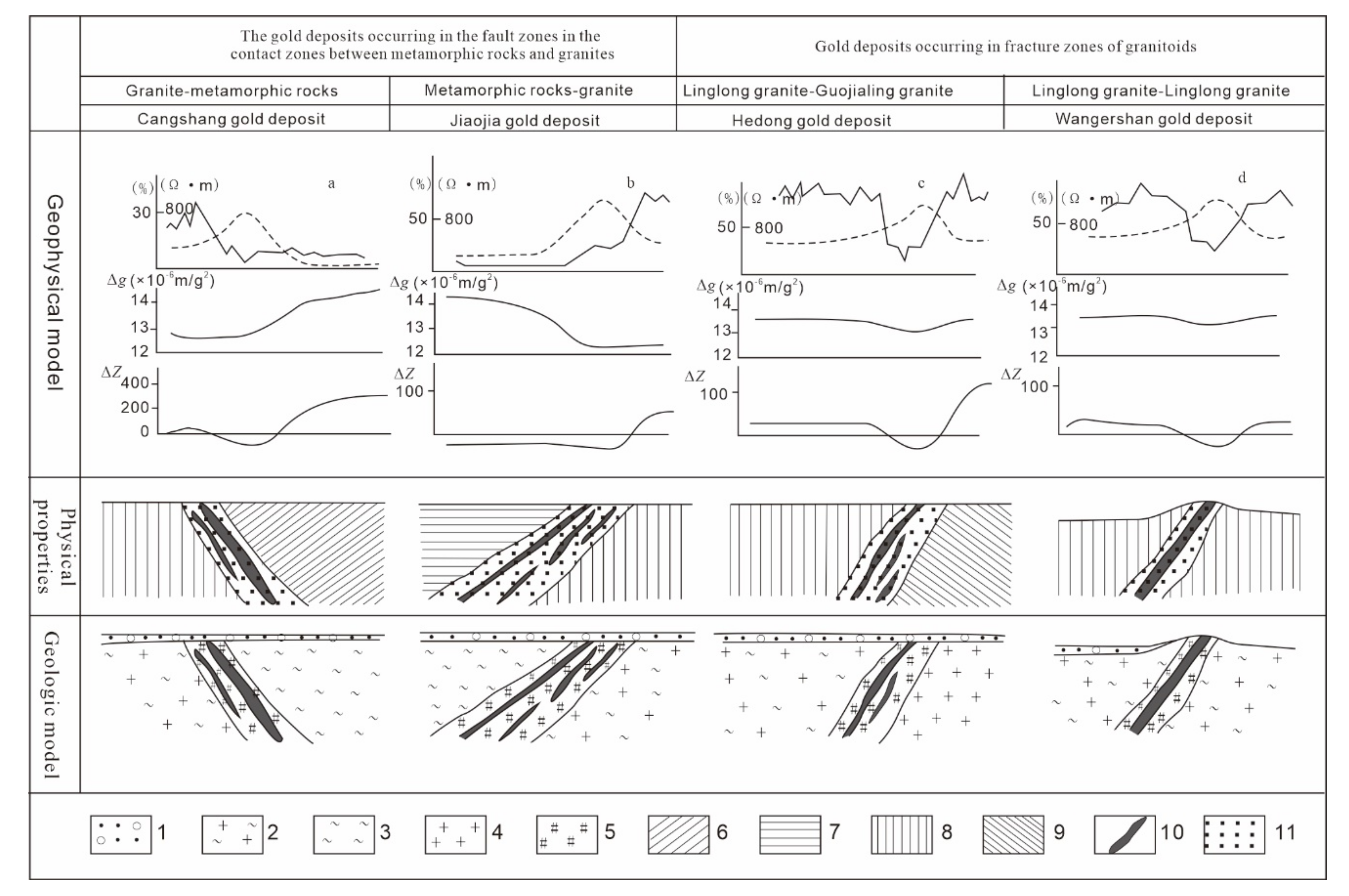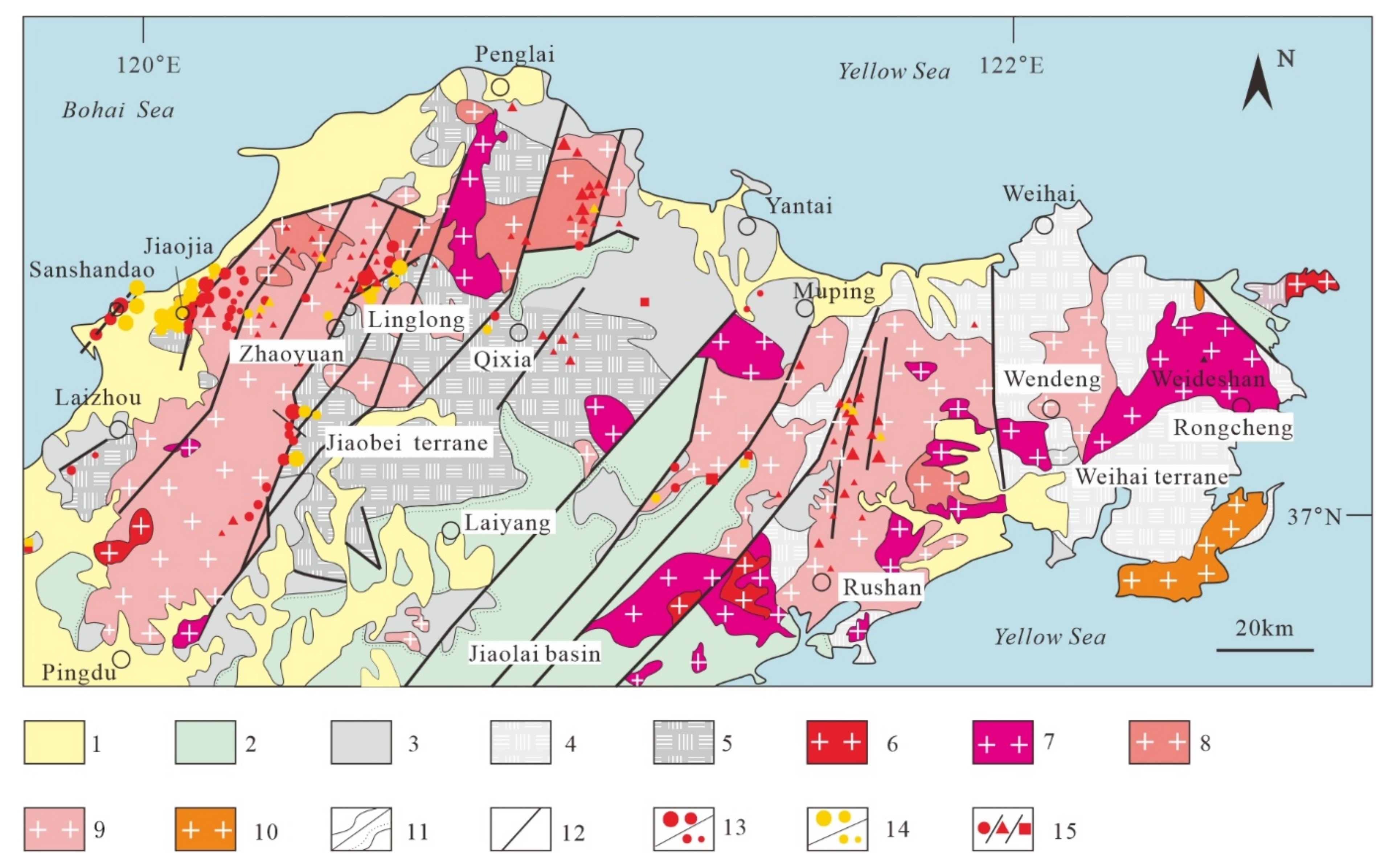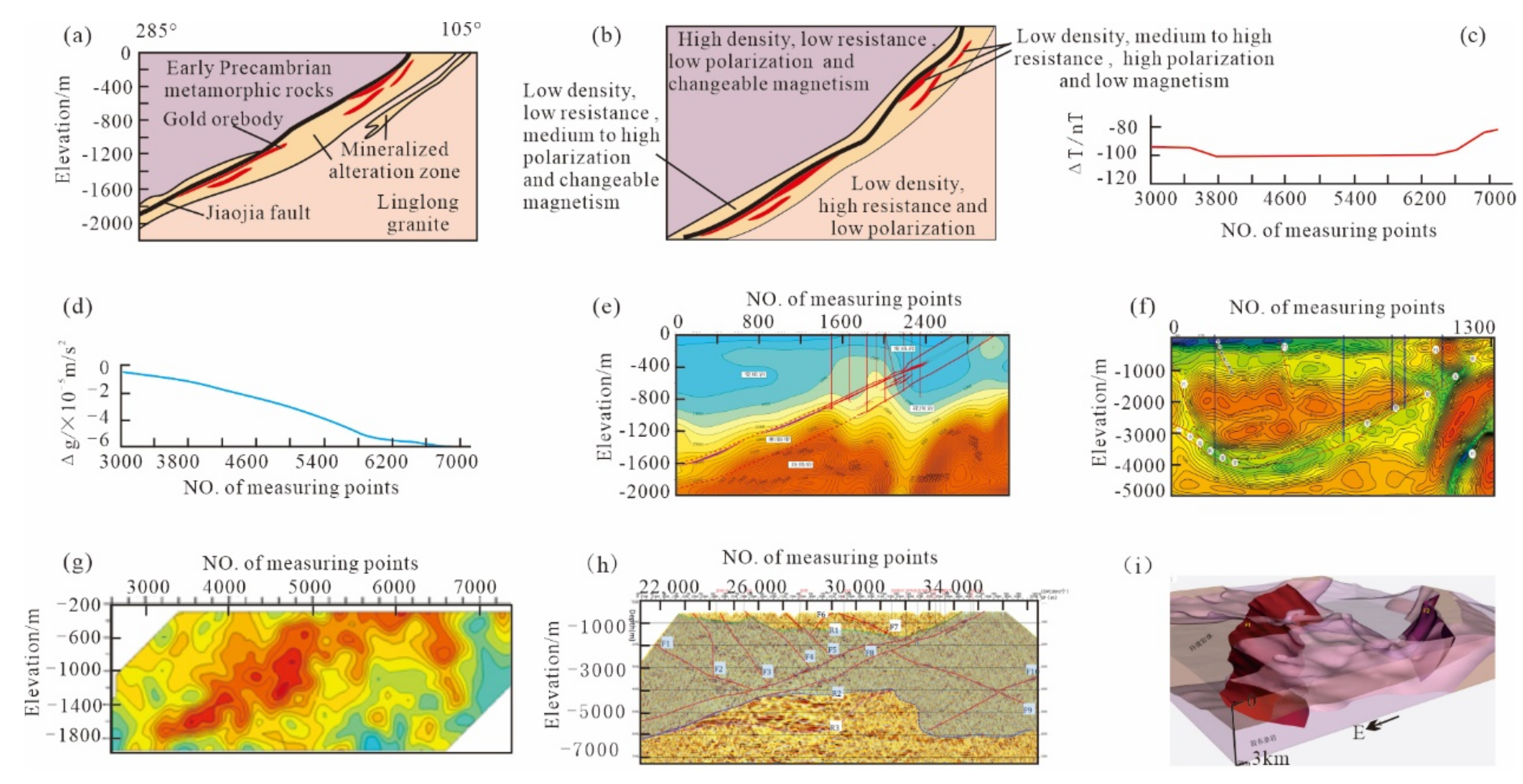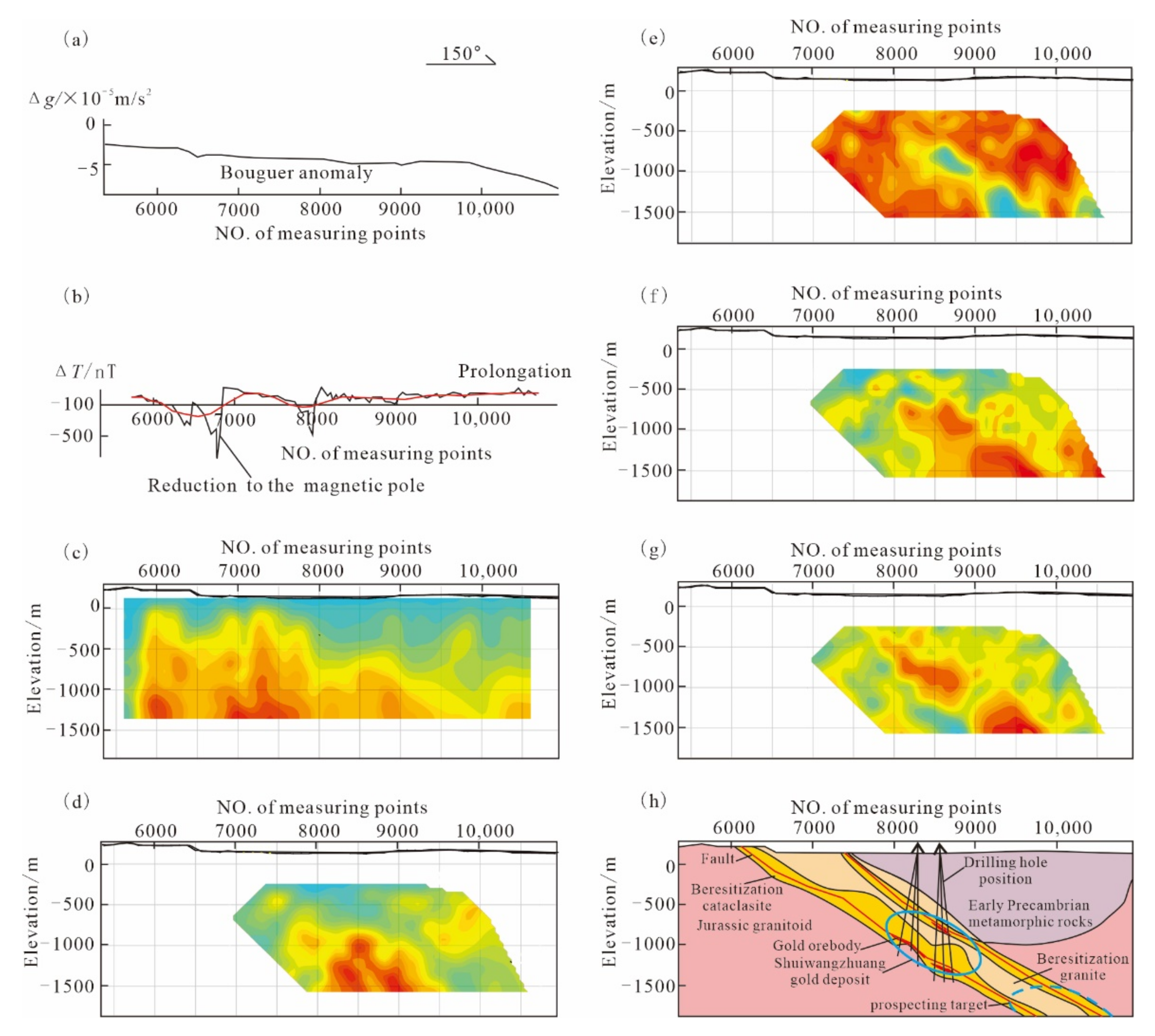A Geological-Geophysical Prospecting Model for Deep-Seated Gold Deposits in the Jiaodong Peninsula, China
Abstract
:1. Introduction
2. Overview of Metallogenic Geological Background and Prospecting Methods of Superficial Gold Deposits
2.1. Overview of Geology and Gold Mineralization in the Jiaodong Peninsula
2.2. Prospecting Methods of Superficial Gold Deposits
2.3. Geological-Geophysical Prospecting Model of Superficial Gold Deposits
2.3.1. Physical Property Models of Geological Bodies Related to Gold Deposits
- (1)
- Low-polarization, high-density, high-magnetism, and finite homogeneous half-space low-resistance bodies are the reflection of Neoarchean metagabbro (Table 1);
- (2)
- Low-polarization, high-density, low-magnetism, and finite homogeneous half-space low-resistance bodies are the manifestation of Neoarchean TTG gneisses;
- (3)
- Low-polarization, low-density, low-magnetism, and finite homogeneous half-space high-resistance bodies are the reflection of Linglong granite;
- (4)
- Low-polarization, low-density, medium- and high-magnetism, and finite homogeneous half-space high-resistance bodies are the manifestation of Guojialing granite;
- (5)
- Low-magnetism, low-density, high-polarization, and medium- and high-resistance bodies in the shape of infinitely deep and inclined plates are the manifestation of altered fracture zones with weak mineralization (such as sericitization, pyritization and silicification) at the periphery of the orebodies;
- (6)
- Medium-and high-polarization, low-density, low-magnetism, and medium-and high-resistance orebodies in the shape of definitely deep and inclined plates are the reflection of the orebodies.
| Parameters | η (Polarizability)/% | ρ (Resistivity)/Ω•m | σ (Density)/g/m3 | κ (Susceptibility)/×10−6 4π sI | Jr (Remanent Magnetization)/×10−3 A/m | ||||||
|---|---|---|---|---|---|---|---|---|---|---|---|
| Lithology | Relative Change | Variation Range | Relative Change | Variation Range | Relative Change | Variation Range | Relative Change | Variation Range | Relative Change | Variation Range | |
| Metagabbro | Low | 3.0–4.0 | Low | n × 10–300 | High | 2.87 | High | 500–4000 | High | 5–1000 | |
| Gneiss | Low | 3.0–4.0 | Low | n × 10–300 | High | 2.87 | Low | 30–80 | Low | 5–10 | |
| Linglong granite | Low | 4.0–5.0 | High | 2500–4000 | Low | 2.58 | Low | 5–100 | Low | 1–10 | |
| Guojialing granite | Low | 4.0–5.0 | High | 2500–4000 | Low | 2.58 | Medium-high | 50–200 | Medium-high | 5–15 | |
| Fractured altered rock | Low-medium | 6.0–8.0 | Slightly low | 600–850 | Low | 2.50 | Low | 5–10 | Low | 0–2 | |
| Orebody and mineralized altered rock | High | 20–25 | Medium-high | 1000–2000 | Low | 2.62–2.75 | Low | 5–15 | Low | 0–5 | |
2.3.2. Geophysical Prospecting Models for Superficial Gold Deposits
- (1)
- Gold deposits in the fractured, altered contact zone between metagabbro and Linglong granite. Their physical property model is the combination of the a, c, e, and f types. The gravity and magnetism above orebodies appear as gradient zones with contour values gradually increasing and accompanied by low values. These correspond to the characteristics of high polarization and secondary high resistance (Figure 2a).
- (2)
- Gold deposits in the fractured altered contact zone between TTG gneiss and Linglong granite. Their physical property model is the combination of the b, c, e, and f types. The gravity and magnetism above orebodies exhibit the characteristics of transitional zones with contour values decreasing and magnetic anomalous values increasing, and are accompanied by low anomalous values. These correspond to the characteristics of high polarization anomalies and secondary high resistance (Figure 2b).
- (3)
- Gold deposits in the fractured altered contact zone between Linglong granite and Guojialing granite. Their physical property model is the combination of the c, d, e, and f types. These exhibit weak low gravity values above the orebodies, and correspond to the characteristics of weak magnetic gradient zones, high polarization anomalies, and low resistance (Figure 2c).
- (4)
- Gold deposits in the fractured altered zone type inside the Linglong granite. Their physical property model is the combination of the c, e, f, and c types. These exhibit weak low gravity and magnetism values above the orebodies. They correspond to high-induced polarization anomalies and low-resistance anomalies (Figure 2d).

3. Stepped Metallogenic Model of Deep-Seated Gold Deposits
3.1. Stepped Metallogenic Model of Deep-Seated Gold Deposits
- (1)
- With the dip angle changing in an alternate steep and gentle manner along the dip direction, the ore-controlling faults exhibit stepped distribution characteristics;
- (2)
- Due to the intermittent enrichment of mineralization from shallow to deep parts, multiple metallogenic spaces are formed;
- (3)
- Thick and large orebodies tend to be distributed in the turning parts of steep and gentle dip angles and sections with gentle dip angles;
- (4)
- There is limited vertical interval bearing no gold between two adjacent metallogenic steps within a given metallogenic region.
3.2. Mechanisms of the Stepped Metallogenic Model
4. Prospecting Methods and Instruments
4.1. Geophysical Prerequisite for Deep Prospecting
- (1)
- The deposits occur in large-scale regional fault zones. The major ore-controlling faults in northwest Jiaodong include the Sanshandao, Jiaojia, and Zhaoping faults, with respective lengths of 12 km, 60 km and 120 km, and widths of 20–500 m [2]. Compared with the original rocks, the density, resistivity and magnetism of the fault zones are notably lower, whereas the polarizability of the fault zones is notably higher, and generally increases by more than 7% [2]. The gravity, magnetic, and resistivity anomalies are distributed in moniliform and stripped patterns. In the case of the high silicification of rocks in the fault zones, the resistivity of the fault zones will not significantly decrease. When the fault zones are filled with late basic and ultrabasic dykes, their magnetism will significantly increase.
- (2)
- Many gold deposits lie in the contact zones between the Early Precambrian metamorphic rocks and Mesozoic granites, which differ notably in terms of resistivity, polarizability, and magnetism (Table 1).
- (3)
- The Early Precambrian metamorphic rocks are closely related to the gold deposits; thus, the distribution areas of metamorphic rock series are the stratigraphic basis for deep prospecting. Compared with the Mesozoic granitoids, the Early Precambrian metamorphic rocks are characterized by high density, low resistance, low polarization, and uneven and greatly varying magnetism.
- (4)
- The concentration areas of the gold deposits are generally distributed inside, on the edges of, and in the surrounding areas of the complex rock masses composed of Linglong and Guojialing granite. This type of rock association is characterized by relatively high resistance, low polarization, and low density. In addition, the Linglong granite exhibits low magnetic susceptibility, whereas the Guojialing granite possesses medium-high magnetic susceptibility. In terms of gravity anomalies, the concentration areas are located on the edges of the areas with low gravity anomalous values (i.e., the transitional zones between high and low gravity anomalous values) and within the contact zones between large-scale low and high gravity anomalies. In addition, the edges of small-scale blocky and moniliform positive magnetic anomalies are areas which are favorable to deep-seated gold mineralization. In terms of resistivity, the concentration areas are located at the typical interfaces between electric fields with high and low resistance.
4.2. High Precision Gravity and Magnetic Exploration Method
4.3. Electromagnetic Prospecting Method
4.4. Reflection Seismic Exploration Methods
4.5. Technical Methods Applicable to Different Interference Conditions
5. Results: Prospecting Model for Deep-Seated Gold Deposits and Application Demonstration
5.1. Multi-Parameter Geological-Geophysical Prospecting Model for Deep-Seated Gold Deposits
5.1.1. Characteristics of Gravity and Magnetic Fields
5.1.2. Resistivity Anomalies
5.1.3. Polarizability Anomalies
5.1.4. Characteristics of Seismic Reflection
5.1.5. 3D Spatial Characteristics
5.2. Demonstration of Geophysical Prospecting of Deep-Seated Gold Deposits in the Shuiwangzhuang Mining Area, Jiaodong Peninsula
6. Conclusions
- (1)
- The ideas and methods of deep prospecting differ significantly from those of shallow prospecting. The traditional shallow gold prospecting in the Jiaodong Peninsula mainly involves using the time domain electric method to delineate the mineralized anomaly body, whereas for deep-seated gold prospecting the frequency domain electromagnetic method and reflection seismic method are mainly adopted to determine the extension characteristics of the ore-controlling faults in the deep areas.
- (2)
- The gold deposits in the Jiaodong Peninsula are controlled by large-scale regional faults. The orebodies are mainly distributed throughout the turning areas of steep to gentle dip angles. The ore-hosting faults developed along the contact interfaces between the Early Precambrian metamorphic rocks and Mesozoic granitoids exhibit a stepped metallogenic model in the downward direction. This model provides a technical premise and key exploration target for the geophysical exploration of deep-seated gold deposits.
- (3)
- The key indicators of multi-parameter geological-geophysical prospecting model to identify deep-seated gold deposits include the following: stepped metallogenic model; gravity gradient zones, beaded and elongated high magnetic anomaly zones; turning part of high- and low- resistance zones; high-value anomalies of complex resistivity, apparent chargeability and relaxation time constant; low-value anomalies of frequency-dependence coefficient; and undulating seismic reflection waves.
- (4)
- Through the demonstration of geophysical exploration of deep-seated gold deposit in the Shuiwangzhuang mining area, the deep prospecting target area has been delineated at the elevation depth of −1000 m, and has been verified by drilling.
Author Contributions
Funding
Institutional Review Board Statement
Informed Consent Statement
Data Availability Statement
Acknowledgments
Conflicts of Interest
References
- Song, M.C.; Song, Y.X.; Ding, Z.J.; Wei, X.F.; Sun, S.L.; Song, G.Z.; Zhang, J.J.; Zhang, P.J.; Wang, Y.G. The discovery of The Jiaojia and the Sanshandao giant gold deposits in Jiaodong Peninsula and discussion on the relevant issues. Geotecton. Metallog. 2019, 43, 92–110, (In Chinese with English Abstract). [Google Scholar] [CrossRef]
- Li, S.X.; Liu, C.C.; An, Y.H. Geology of Gold Deposits in Shandong Peninsula; Geological Publishing House: Beijing, China, 2007. (In Chinese) [Google Scholar]
- Cao, C.G.; Yu, Y.W.; Guo, G.Q.; He, C.Y.; Wang, Y.; Zhang, C. Analysis on ore- forming model in deep part of Jijia gold deposit in Sanshandao by using integrated geophysical exploration method. Shandong Land Resour. 2012, 28, 20–25, (In Chinese with English Abstract). [Google Scholar]
- Song, M.C.; Wan, G.P.; Cao, C.G.; He, C.Y. Geophysical-geological interpretation and deep-seated gold deposit prospecting in Sanshandong-Jiaojia area, eastern Shandong Province, China. Acta Geol. Sin. 2012, 86, 640–652. [Google Scholar]
- Yu, X.F.; Shan, W.; Xiong, Y.X.; Geng, K.; Sun, Y.Q.; Chi, N.J.; Guo, B.F.; Li, D.P.; Li, H.K.; Song, Y.X.; et al. Structural framework and genetic analysis of gold concentration areas in the northwestern Jiaodong Peninsula, China: A new understanding based on high-resolution reflective seismic survey. Acta Geol. Sin. 2018, 92, 1823–1840. [Google Scholar] [CrossRef]
- Drummond, B.J.; Goleby, B.R. Seismic reflection images of the major ore-controlling structures in the eastern goldfields province Western Australia. Explor. Geophys. 1993, 24, 473–478. [Google Scholar] [CrossRef]
- West, D.; Witherly, K. Geophysical exploration for gold in deeply weathered terrains, two tropical cases. Explor. Geophys. 1995, 26, 124–130. [Google Scholar] [CrossRef]
- Takakura, S. CSAMT and MT investigations of an active gold depositing environment in the Osorezan geothermal area, Japan. Explor. Geophys. 1995, 26, 172–178. [Google Scholar] [CrossRef]
- Routh, P.S.; Oldenburg, D.W. Inversion of controlled source audio-frequency magnetotellurics data for a horizontally layered earth. Geophysics 1999, 64, 1689–1697. [Google Scholar] [CrossRef]
- Hinze, W.J.; Von Frese, R.R.B.; Saad, A.H. Gravity and Magnetic Exploration: Principles, Practices and Applications; Cambridge University Press: Cambridge, UK, 2013. [Google Scholar]
- Di, Q.Y.; Xue, G.Q.; Yin, C.C.; Li, X. New methods of controlled-source electromagnetic detection in China. Sci. China Earth Sci. 2020, 50, 1219–1227. [Google Scholar] [CrossRef]
- Di, Q.Y.; Xue, G.Q.; Zeng, Q.D.; Wang, Z.X.; An, Z.G.; Lei, D. Magnetotelluric exploration of deep-seated gold deposits in the Qingchengzi orefield, eastern Liaoning (China), using a SEP system. Ore Geol. Rev. 2020, 122, 103501. [Google Scholar] [CrossRef]
- Guo, Z.W.; Xue, G.Q. Electromagnetic methods for mineral exploration in China: A review. Ore Geol. Rev. 2020, 118, 103357. [Google Scholar] [CrossRef]
- Xue, G.Q.; Li, Z.Y.; Guo, W.B.; Fan, J.S. The exploration of sedimentary bauxite deposits using the reflection seismic method: A case study from the Henan Province, China. Ore Geol. Rev. 2020, 127, 103832. [Google Scholar] [CrossRef]
- Xue, G.Q.; Zhang, L.B.; Hou, D.Y.; Liu, H.T.; Luo, X.N. Integrated geological and geophysical investigations for the discovery of deeply buried gold–polymetallic deposits in China. Geol. J. 2020, 55, 1771–1780. [Google Scholar] [CrossRef]
- Song, M.C.; Li, S.Z.; Santosh, M.; Zhao, S.J.; Yu, S.; Yi, P.H.; Cun, S.X.; Lv, G.X.; Xu, J.X.; Song, Y.X.; et al. Types, characteristics and metallogenesis of gold deposits in the Jiaodong Peninsula, Eastern North China Craton. Ore Geol. Rev. 2015, 65, 612–625. [Google Scholar] [CrossRef]
- Charles, N.; Gumiaux, C.; Augier, R.; Chen, Y.; Zhu, R.X.; Lin, W. Metamorphic core complexes vs. synkinematic plutons in continental extension setting: Insights from key structures (Shandong Province, eastern China). J. Asian Earth Sci. 2011, 40, 261–278. [Google Scholar] [CrossRef] [Green Version]
- Charles, N.; Augier, R.; Gumiaux, C.; Monié, P.; Chen, Y.; Faure, M.; Zhu, R.X. Timing, duration and role of magmatism in wide rift systems: Insights from the Jiaodong Peninsula (China, East Asia). Gondwana Res. 2013, 24, 412–428. [Google Scholar] [CrossRef] [Green Version]
- Yang, Q.Y.; Santosh, M. Early Cretaceous magma flare-up and its implications on gold mineralization in the Jiaodong Peninsula, China. Ore Geol. Rev. 2015, 65, 626–642. [Google Scholar] [CrossRef]
- Goss, S.; Wilde, S.; Wu, F.Y.; Yang, J.H. The age, isotopic signature and significance of the youngest Mesozoic granitoids in the Jiaodong Terrene, Shandong Province, North China Craton. Lithos 2010, 120, 309–326. [Google Scholar] [CrossRef]
- Ma, L.; Jiang, S.Y.; Hofmann, A.; Xu, Y.G.; Hou, M.L. Rapid lithospheric thinning of the North China Craton: New evidence from cretaceous mafic dikes in the Jiaodong Peninsula. Chem. Geol. 2016, 432, 1–15. [Google Scholar] [CrossRef] [Green Version]
- Yan, Q.S.; Metcalfe, I.; Shi, X.F.; Zhang, P.Y.; Li, F.C. Early Cretaceous granitic rocks from the southern Jiaodong Peninsula, eastern China: Implications for lithospheric extension. Int. Geol. Rev. 2019, 61, 821–838. [Google Scholar] [CrossRef]
- Yang, L.Q.; Deng, J.; Wang, Z.L.; Zhang, L.; Guo, L.N.; Song, M.C.; Zheng, X.L. Mesozoic gold metallogenic system of the Jiaodong gold province, eastern China. Acta Petrol. Sin. 2014, 30, 2447–2467, (In Chinese with English Abstract). [Google Scholar]
- Goldfarb, R.J.; Santosh, M. The dilemma of the Jiaodong gold deposits: Are they unique? Geosci. Front. 2014, 5, 139–153. [Google Scholar] [CrossRef] [Green Version]
- Li, L.; Santosh, M.; Li, S.R. The “Jiaodong type” gold deposits: Characteristics, origin and prospecting. Ore Geol. Rev. 2015, 65, 589–611. [Google Scholar] [CrossRef]
- Mills, S.E.; Tomkins, A.G.; Weinberg, R.F.; Fan, H.R. Implications of pyrite geochemistry for gold mineralisation and remobilisation in the Jiaodong gold district, Northeast China. Ore Geol. Rev. 2015, 71, 150–168. [Google Scholar] [CrossRef]
- De Boorder, H. The Jiaodong gold district, northeastern China, in the context of the Late Paleozoic and Late Mesozoic large igneous provinces, orogeny and metallogeny in Eurasia. Ore Geol. Rev. 2015, 65, 574–588. [Google Scholar] [CrossRef]
- Groves, D.I.; Santosh, M. The giant Jiaodong gold province: The key to a unified model for orogenic gold deposits? Geosci. Front. 2016, 7, 409–417. [Google Scholar] [CrossRef] [Green Version]
- Wang, S.R.; Yang, L.Q.; Wang, J.G.; Wang, E.J.; Xu, Y.L. Geostatistical determination of ore shoot plunge and structural control of the Sizhuang world-class epizonal orogenic gold deposit, Jiaodong Peninsula, China. Minerals 2019, 9, 214. [Google Scholar] [CrossRef] [Green Version]
- Wei, Y.J.; Yang, L.Q.; Feng, J.Q.; Wang, H.; Lv, G.Y.; Li, W.C.; Liu, S.G. Ore-fluid evolution of the Sizhuang orogenic gold deposit, Jiaodong Peninsula, China. Minerals 2019, 9, 190. [Google Scholar] [CrossRef] [Green Version]
- Chen, B.H.; Deng, J.; Wei, H.T.; Ji, X.Z. Trace element geochemistry in quartz in the Jinqingding gold deposit, Jiaodong Peninsula, China: Implications for the gold precipitation mechanism. Minerals 2019, 9, 326. [Google Scholar] [CrossRef] [Green Version]
- Deng, J.; Yang, L.Q.; Li, H.R.; Groves, D.I.; Wang, S.R. Regional structural control on the distribution of world-class gold deposits: An overview from the Giant Jiaodong Gold Province, China. Geol. J. 2019, 54, 378–391. [Google Scholar] [CrossRef] [Green Version]
- Groves, D.I.; Santosh, M.; Deng, J.; Wang, Q.F.; Zhang, L. A holistic model for the origin of orogenic gold deposits and its implications for exploration. Miner. Depos. 2020, 55, 275–292. [Google Scholar] [CrossRef]
- Deng, J.; Wang, Q.F.; Santosh, M.; Liu, X.F.; Liang, Y.Y.; Yang, L.Q.; Zhao, R.; Yang, L. Remobilization of metasomatized mantle lithosphere: A new model for the Jiaodong gold province, eastern China. Miner. Depos. 2020, 55, 257–274. [Google Scholar] [CrossRef]
- Song, M.C.; Yi, P.H.; Xu, J.X.; Cui, S.X.; Shen, K.; Jiang, H.L.; Yuan, W.H.; Wang, H.J. A step metallogenetic model for gold deposits in the northwestern Shandong Peninsula, China. Sci. China Earth Sci. 2012, 55, 940–948. [Google Scholar] [CrossRef]
- Song, M.C.; Lin, S.Y.; Yang, L.Q.; Song, Y.X.; Ding, Z.J.; Li, J.; Li, S.Y.; Zhou, M.L. Metallogenic model of Jiaodong Peninsula gold deposits. Miner. Depos. 2020, 39, 215–236, (In Chinese with English Abstract). [Google Scholar]
- Cox, S.F. Coupling between deformation, fluid pressures, and fluid flow in ore-producing hydrothermal systems at depth in the crust. In Economic Geology 100th Anniversary Volume; Society of Economic Geologists: Littleton, CO, USA, 2005; pp. 39–75. [Google Scholar]
- Groves, D.I.; Santosh, M.; Goldfarb, R.J.; Zhang, L. Structural geometry of orogenic gold deposits: Implications for exploration for world-class and giant deposits. Geosci. Front. 2018, 9, 1163–1177. [Google Scholar] [CrossRef]
- Li, J.; Zhang, L.P.; Song, M.C.; Liang, J.L.; Li, S.Y.; Song, Y.X.; Bao, Z.Y.; Ding, Z.J. Formation mechanism of Shuiwangzhuang gold deposit in Jiaodong Peninsula: Constraints from S-H-O isotopes and fluid inclusions. Earth Sci. 2021, 46, 1569–1584, (In Chinese with English Abstract). [Google Scholar] [CrossRef]




| Exploration Target | Sound Intensity | Effective Method | Optimal Combination | |
|---|---|---|---|---|
| Noise Condition | Combination of Methods | |||
| Ore-controlling structural plane | Medium (weak) noise | CSAMT | Weak noise | AMT + gravity prospecting |
| AMT | ||||
| WFEM | ||||
| Seismic exploration | Medium noise | CSAMT/WFEM + gravity prospecting | ||
| Gravity prospecting | ||||
| Strong noise | Gravity prospecting | Combination of dominant gravity prospecting and seismic exploration and auxiliary WFEM method | ||
| Seismic exploration | ||||
| WFEM | ||||
| Highly polarized body (mineralized alteration zone) | Medium (weak) noise | SIP | ||
Publisher’s Note: MDPI stays neutral with regard to jurisdictional claims in published maps and institutional affiliations. |
© 2021 by the authors. Licensee MDPI, Basel, Switzerland. This article is an open access article distributed under the terms and conditions of the Creative Commons Attribution (CC BY) license (https://creativecommons.org/licenses/by/4.0/).
Share and Cite
Song, M.; Xue, G.; Liu, H.; Li, Y.; He, C.; Wang, H.; Wang, B.; Song, Y.; Li, S. A Geological-Geophysical Prospecting Model for Deep-Seated Gold Deposits in the Jiaodong Peninsula, China. Minerals 2021, 11, 1393. https://doi.org/10.3390/min11121393
Song M, Xue G, Liu H, Li Y, He C, Wang H, Wang B, Song Y, Li S. A Geological-Geophysical Prospecting Model for Deep-Seated Gold Deposits in the Jiaodong Peninsula, China. Minerals. 2021; 11(12):1393. https://doi.org/10.3390/min11121393
Chicago/Turabian StyleSong, Mingchun, Guoqiang Xue, Hongbo Liu, Yixin Li, Chunyan He, Hongjun Wang, Bin Wang, Yingxin Song, and Shiyong Li. 2021. "A Geological-Geophysical Prospecting Model for Deep-Seated Gold Deposits in the Jiaodong Peninsula, China" Minerals 11, no. 12: 1393. https://doi.org/10.3390/min11121393
APA StyleSong, M., Xue, G., Liu, H., Li, Y., He, C., Wang, H., Wang, B., Song, Y., & Li, S. (2021). A Geological-Geophysical Prospecting Model for Deep-Seated Gold Deposits in the Jiaodong Peninsula, China. Minerals, 11(12), 1393. https://doi.org/10.3390/min11121393






